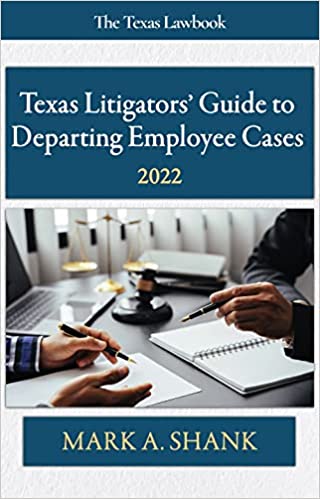Your client arrives at her office Monday morning to learn that three employees are leaving her company to work for a direct competitor. She immediately calls you for advice. Hopefully, you already have a copy Texas Litigators’ Guide to Departing Employee Cases handy. In addition, this article covers what attorneys should consider when developing their initial case strategies and possible action items in connection with them.
For clarity, this article is written from the perspective of the former employer’s counsel in the context of a departing employee who is in known (or suspected) breach of a covenant not to compete or solicit.

Please visit Texas Lawbook Publishing to order your copy of The Texas Litigator’s Guide to Departing Employee Cases. The first 50 people to place their order will receive a signed copy.
Phase One: Triage
Damage control is the name of the game for an employer client in the immediate aftermath of receiving notice of a departing employee. This is the time to raise the drawbridge, plug all the leaks and mitigate the risk the departing employee poses to the company as much as possible. In this crucial early stage, attorneys should advise their clients to consider the following actions:
- Remove the departing employee’s access to all company data, including hard copy files, e-mail accounts, servers, cloud-based data management systems, messaging platforms, etc.
- If the departing employee is on-site, request the immediate turnover of all company hardware, including laptops, tablets and cellphones.
- If feasible, conduct an exit interview to learn about the new employment, including details about the company, start dates and the types of tasks the departing employee contemplates he or she will be performing. During this conversation, an employer may also be able to determine helpful details about how and when the departing employee was solicited (if applicable) for the new position. Importantly, the departing employee should be reminded of his or her common law and contractual obligations, including all applicable restrictive covenants and told that those obligations will be enforced by the company. This is also a good time to deliver hard copies of all signed agreements containing post-employment obligations and restrictive covenants to the departing employee.
During this time, it is of the utmost importance for the client to remain professional and cognizant that, should litigation arise, the details of the employee’s departure will be told (and retold) in affidavits, exhibits and on the witness stand. This process will likely not be perfect, but it should be devoid of threats, personal attacks and reactionary e-mails and text messages that will live forever in infamy.
Phase Two: Investigation
While this phase begins concurrently with the first, the client will likely have more time to dedicate to fact and data gathering following its initial triage of the situation. This step is vital for properly positioning the client for any litigation (including applications for injunctive relief) that may be necessary, as well as for any pre-suit resolution discussions that may arise. By identifying as many of the critical pieces of evidence as early as possible, an employer’s attorney can start the case from a position of strength – be it a conversation with opposing counsel or the first, tone-setting five minutes of a TRO hearing. Here are a few things attorneys should advise an employer client to consider doing during this investigation phase:
- At the outset, encourage the client to be as organized as possible prior to sending documents and information. This is one of the most helpful and cost-effective measures a client can take, especially in a situation involving injunction practice. In most instances, the client is in the best position to know the context of each document and why it might be relevant. The more document organization the client can do on the front end, the less time and money attorneys have to spend trying to wade through it. If possible, have the client set up a DropBox (or other type of secure, file-share system) organized with relevant subfolders (e.g., “Employment Agreement(s),” “Correspondence,” “Damages,” etc.) and avoid simply forwarding emails with multiple attachments.
- As previewed above, have the IT department, a tech-savvy employee or a vendor preserve all evidence and review the departing employee’s devices to determine whether he or she may have improperly distributed the company’s proprietary, confidential and/or trade secret information. This search should not be exclusively limited to the departing employee’s e-mail account (although, that is a great place to start) but should also cover any web-based systems (e.g., DropBox, Google Drive, etc.) that the departing employee may have used to upload company data and any downloads that may have occurred using an external storage device (e.g., flash drive, hard drive, etc.). If accessible, there are also programs that identify and, sometimes, enable the recovery of “deleted” information. Nothing lasts forever, but computer files are pretty close.
- Talk to the supervisors or employees who worked most closely with the departing employee to gather information. Avoid making these conversations feel like interrogations and be mindful of personal relationships that may exist outside of the office. Do not overshare, especially as it relates to attorney-client communications. Do not speak poorly of the departing employee.
- Make a “Cast of Characters” list of all the people in the company who may have relevant knowledge about the case, including their contact details and a brief description of their relationship to the matter (e.g., “Direct of Department, who supervised Departing-Employee Joe for the past five years and spoke with him in April about Competitor X”).
- Do a social media search. It is truly remarkable what key facts and evidence can be pulled from a Facebook or Twitter page. A photo of Departing-Employee Joe fishing on a boat with the new employer’s CEO can be worth a thousand words.
- Have the client create a timeline of relevant events. Like the upfront document organization and cast-of-characters list, this will be key work product that will help the attorney digest and understand the case quicker, save the client money and reduce ramp-up time in matters that are often time sensitive.
Phase Three: Implement and Execute
Now it is time to implement the strategy and execute. (Note that, in circumstances where emergency injunctive relief is required, fact and evidence gathering may be concurrent with execution, e.g., the drafting of a TRO Application.) Here, the circumstances of each case will dictate a wide variety of possible litigation and/or settlement pathways. That said, below are some actions the client can authorize irrespective of which direction the case ultimately goes:
- Send a cease and desist letter. This is an important step, even if it is considered unlikely that certain breaches will “cease” or “desist” absent litigation. Such a letter, which will undoubtedly be an exhibit at a hearing and/or trial, is also a good first shot across the bow to the new employer, who will be forced to face the reality of potential litigation and the business disruption that entails. In addition to demands for the departing employee to cease his or her breaches, this letter can: preview tortious interference claims, if any, against the new employer; demand that all proprietary information is returned (and use of same ceases); and, importantly, put the departing employee and new employer on formal, written notice of their evidentiary preservation obligations under Texas law. Depending on the situation, this letter can also invite further discussion with opposing counsel to explore potential resolution. An attorney should be sure to avoid waiving any rights and remedies in these letters, and a prudent practice is to consider including language to that effect. Although sending a cease and desist letter may create a risk that opposing counsel will file a declaratory judgment action to grab a preferable venue, this risk is often minimal and outweighed by the benefits discussed above.
- Consider sending opposing counsel a draft lawsuit or TRO. While the defendant(s) will be slightly more prepared to address legal and factual positions if litigation ensues, it can be helpful for an opponent to see – in the form of a lawsuit – that the former employer is willing to go the distance to enforce its covenants, especially in cases where the dynamics suggest settlement may be possible. This act can result in momentum toward resolution and all parties being able to move on with their respective businesses.
- Determine whether or not to sue. A good litigator is a great counselor. The client should fully understand the risks and costs of litigation, so that those considerations can be properly weighed against the need for accountability. For example, is the noncompete close to expiring? Is the compromised data or proprietary information outdated? Does the former employer fear that other employees might leave and sees value in communicating the message that its restrictive covenants will be enforced? Is the potential damage to the former employer extensive? What court or courts are potential venues? The reality is that litigation is expensive and, at times, messy. Clients and customers may be on the receiving end of subpoenas, and depositions may publicly reveal information that a company and/or individual(s) would rather keep private. The reach of discovery can be broad. This is not to say that litigation may not be necessary. Sometimes it is the only option. However, it is a decision that should not be made lightly.
No two cases are alike, and each case must be viewed and analyzed in light of its unique facts and circumstances. Departing employee cases can be fast and furious and often involve a mix of litigation (e.g., obtaining a TRO) and cooperation (e.g., entering an agreed TI while resolution is discussed). However, developing a strategy like the one outlined above and considering what action items may be appropriate, will help attorneys competently navigate their cases and, ideally, obtain the most beneficial results possible for their clients.

Dave Wishnew is a Dallas trial lawyer and founding partner of Crawford Wishnew Lang. He is an assistant editor of the 2022 Texas Litigators’ Guide to Departing Employee Cases.

Ali Ohlinger is an attorney at Crawford Wishnew Lang. She focuses her practice on complex commercial disputes, as well as fiduciary and trust disputes.
